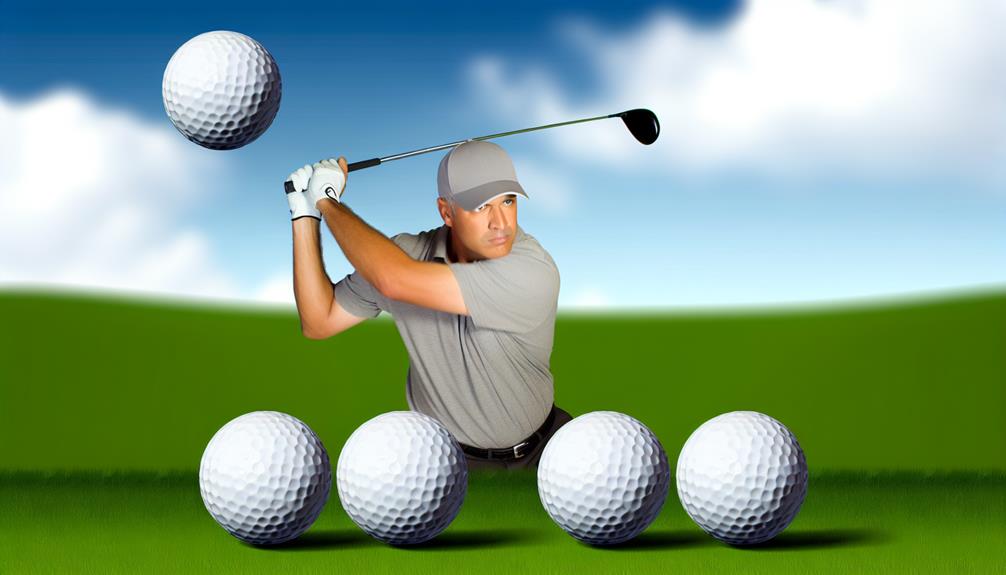In the sophisticated world of golf, it's not just about swinging your clubs with grace and precision. It also involves choosing the right ammunition, if you catch my drift.
You're likely wondering why it's so crucial to pick the best golf balls for distance. The answer is more profound than you might think. It's not just the satisfying sensation of watching your ball soar into the horizon, there are tangible benefits to your overall game.
But what are these benefits? Well, let's just say they could be the difference between a triumphant strut towards the 18th hole and a disheartening trudge of defeat.
Understanding Golf Ball Distance
To maximize your game, it's essential to understand how the design and construction of a golf ball can significantly affect its travel distance. Disregard distance myths that suggest all balls will travel the same distance. It's simply not true. The reality is that a ball's structure, from its core to its cover, can have a profound impact on how far it flies.
Let's delve into the impact factors. The core, usually made of rubber or synthetic materials, determines the ball's initial velocity and spin rate. A solid-core ball will typically generate more distance than a wound ball.
The cover, typically made of urethane or Surlyn, affects the ball's aerodynamics, durability, and spin rate. Urethane covers are softer and provide more spin, while Surlyn covers are harder and more durable, offering less spin but more distance.
The dimple pattern on the ball's surface also plays a critical role. Dimples reduce air resistance, allowing the ball to travel further. A well-designed dimple pattern can add significant yardage to your drives.
Top 5 Distance-Increasing Golf Balls
Now that you've grasped how golf ball construction affects distance, let's examine the top 5 golf balls on the market specifically designed to increase your driving range.
- Titleist Pro V1: This brand's impact on distance is significant; it's renowned for superior distance and consistent flight. Its innovative design minimizes spin for longer drives.
- Callaway Chrome Soft: This ball's strength lies in its spin control efficiency. The dual SoftFast core promotes higher launch and lower spin off the tee for extra yardage.
- Bridgestone Tour B RX: Its advanced aerodynamics increase distance by reducing drag and optimizing trajectory. Brand reputation adds to its appeal.
- TaylorMade TP5x: This 5-layer ball maximizes distance by generating low drag and high lift. It's known for its excellent spin control and speed.
- Srixon Z-Star XV: This ball's energetic gradient growth core gives it a high compression, perfect for distance. Srixon's Spin Skin technology also enhances control.
Features of High-Distance Golf Balls
Understanding the features of high-distance golf balls can significantly improve your game, as they're specifically engineered to maximize distance, optimize spin, and enhance overall performance. When examining ball construction, you'll notice these balls usually boast multi-layer designs. This structure enhances the transfer of energy from the club to the ball, propelling it further.
A soft inner core absorbs impact, reducing spin rates on long drives. A firm outer layer, often crafted from urethane, promotes higher spin on short shots for better control. The combo of these layers results in a ball that flies far and straight off the tee but still performs well on the green.
Spin rates are another key feature of high-distance balls. Lower spin rates on drives prevent the ball from veering off course, keeping your shots on target. Meanwhile, higher spin rates on short game shots provide the control you need around the green.
Choosing a high-distance golf ball isn't just about gaining yards. It's about understanding the ball's features and how they can benefit your game. By comprehending the importance of ball construction and spin rates, you're one step closer to selecting the perfect ball for your gameplay.
Comparing Best Distance Golf Balls
When it comes to comparing the best distance golf balls on the market, you'll want to consider factors such as material, design, spin rate, and price. Distance ball materials are crucial, as they affect the ball's durability and performance. For instance, urethane-covered balls are renowned for their soft feel and high spin rate, making them ideal for long drives.
Golf ball aerodynamics, too, plays a crucial role. A ball with a well-structured dimple pattern reduces drag and enhances lift, allowing it to travel further. However, the spin rate, determined by the ball's design, can either make or break your game. High spinning balls provide control and accuracy but may sacrifice distance.
Price is also a determining factor. Premium balls boast superior materials and design but come with a heftier price tag. On the other hand, budget-friendly balls mightn't deliver the same performance but can still offer decent distance.
Choosing Your Ideal Golf Ball
Navigating through the numerous golf ball options, you'll want to zero in on those that not only maximize your distance but also complement your style of play and skill level. It's not just about picking the most expensive ball on the shelf; it's about understanding the golf ball materials and how they affect ball flight dynamics.
Golf balls are typically made of two core materials: Surlyn and Urethane. Surlyn-covered balls are harder, offering more distance but less control. In contrast, Urethane-covered balls provide better control and spin, but may not go as far. Your choice here hinges largely on your skill level and what you value more: distance or control.
Ball flight dynamics, on the other hand, are influenced by the ball's construction. Two-piece balls are perfect for beginners, banking on distance and durability. Three-piece balls offer more spin control for intermediate players, while four and five-piece balls are ideal for advanced players, offering maximum control but requiring a higher swing speed.

